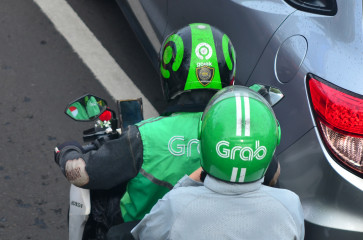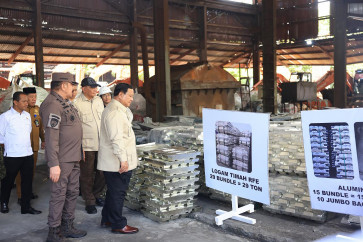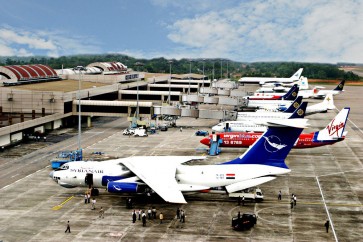Popular Reads
Top Results
Can't find what you're looking for?
View all search resultsPopular Reads
Top Results
Can't find what you're looking for?
View all search resultsTengger community celebrates Karo feast
Running around: The Jaran Kencak decorated horse performance parades down the village roads during Hari Raya Karo
Change text size
Gift Premium Articles
to Anyone
Running around: The Jaran Kencak decorated horse performance parades down the village roads during Hari Raya Karo.
The winding and ascending cement road with muddy holes, as well as steep ravines on both sides, leading to the Bromo-Semeru National Park was quite a challenge to visitors.
Riding on motorcycles or in cars, visitors must at times share the road with big trucks coming down carrying fresh produce.
Unlike on normal days, there were no signs of farmers cultivating their land in the destination village. Instead, traditional Javanese music was vaguely heard and a tent was seen at the village cemetery, while residents invited passersby to enjoy meals with the hosts.
Most residents were well dressed, with women wearing kebaya (long-sleeve blouses) and village officials clad in black costumes. It was the last day of the Hari Raya Karo celebration observed by members of the Tengger ethnic group in Ngadas village, Poncokusumo district, Malang regency, East Java.
The Karo feast has been a tradition of the Tengger community living in the highlands of Bromo-Semeru National Park, covering the regencies of Malang, Lumajang, Probolinggo and Pasuruan. As an expression of gratitude for God's blessings throughout the year, the celebration is also called Riyaya (a religious holiday) as a means of ancestral purification and veneration.
Karo ceremonies lasted for 15 days starting on the 7th of Karo (the second month of the Javanese Saka calendar) and was due to close on the 22nd of Karo. The dates coincide with October or November. 'But the Karo feast isn't held simultaneously like Yadnya Kasada [the major Tengger religious holiday]. Each village has its own calculation and marks the day according to its custom,' said Sutomo, a dukun (shaman) of Ngadas.
The Karo tradition in Ngadas included the rituals of petren (prayers), kauman (dining together), tayuban (folk dancing), tumpeng gede (rice cone offering), sesanti (blessing) and sedekah panggonan or tamping (delivery of food), before being wound up with sadranan (praying and dining at the cemetery) and ujung (rattan whip fighting).
The Karo ceremonies essentially aim at returning to a purity also known as satya yoga. On the last day of Karo, ancestral spirits are asked to return to heaven through a ritual called nyadran or sadranan, during which residents pray for the souls of their ancestors and deceased family members and eat their meals at the cemetery.
Before sadranan and ujung, local residents were gathering in the morning in the house yard of the village head to carry out panggonan or tamping, the delivery of food symbolizing the agricultural produce of Ngadas to the village leader. The food was collected by the villagers and wrapped in sarongs or scarves. After the dukun said a prayer, the food was handed over.
Precaution: Two villagers clashing in an Ujung rattan whip fight, which is meant to invoke security and well-being while at the same time warding off evil things from the village.
Later the village head, dukun and administrative personnel of Ngadas made a pilgrimage to the tomb of the village founder known as Mbah Sedhek in the middle of the rural settlement. The dukun prayed and asked for permission to perform sadranan and ujung to end the entire Karo feast.
At the village cemetery, residents wearing new clothes and carrying their favorite food spread their mats. After paying homage to the graves of families, relatives and revered persons, they prayed for their ancestors under the direction of village elders, followed by dining along with ancestral souls as they savored the homemade meals.
'We always start traditional ceremonies here by opening greetings, Assalamualaikum Wr Wb for Muslims, Hong Ulun Basuki Langgeng for Buddhists and Om Shanti-shanti for Hindus, with prayers said by leading figures of the religions. In this way the village has maintained religious harmony and tolerance,' said Mujiono, the village chief.
As residents were returning home, they were entertained with a Jaran Kencak decorated horse, a Jaran Kepang plaid horse and Bantengan bull performances in a procession that paused for a show in front of the village head's house. The parade was followed by ujung, a traditional fighting contest in which participants beat each other with rattan whips.
Kasiadi, an ujung athlete, said 'The fight is a hobby and part of our way of traditional devotion.' This practice has the aim of invoking security and well-being while warding off evil things that loom over the village and residents with the sacrifice of fighters' blood and injuries.
There are no grudges among participants after their fights as a form of dedication to and respect for their ancestral custom. With all the rituals well preserved, Tengger community members will always be anticipating their togetherness and great delight in the Karo ceremonies of the coming years.
Offering: Villagers waiting for the start of Panggonan (an offering consisting of agricultural produce and cattle) rituals in the house yard of the village head.
' Photos by JP/Aman Rochman













